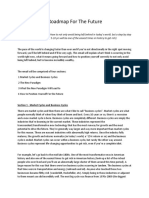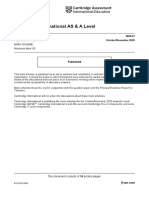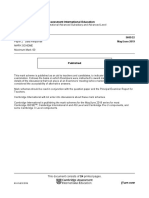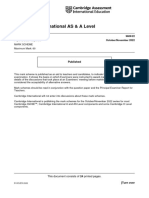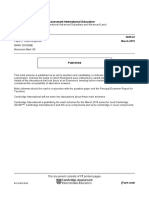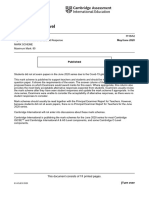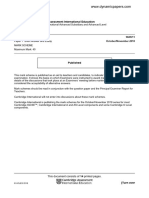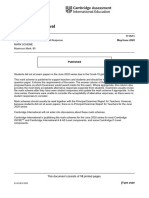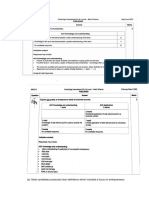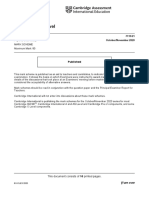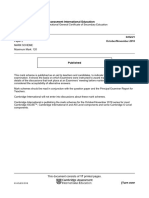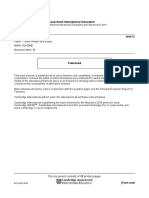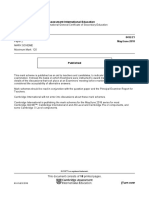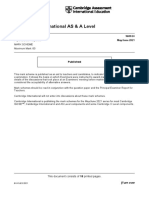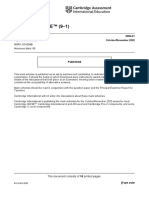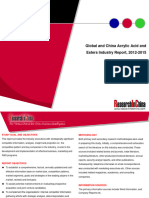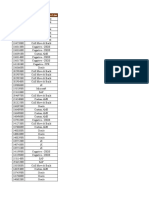Cambridge Assessment International Education: Business 9609/21 May/June 2018
Cambridge Assessment International Education: Business 9609/21 May/June 2018
Uploaded by
badu.augustinekwameCopyright:
Available Formats
Cambridge Assessment International Education: Business 9609/21 May/June 2018
Cambridge Assessment International Education: Business 9609/21 May/June 2018
Uploaded by
badu.augustinekwameOriginal Title
Copyright
Available Formats
Share this document
Did you find this document useful?
Is this content inappropriate?
Copyright:
Available Formats
Cambridge Assessment International Education: Business 9609/21 May/June 2018
Cambridge Assessment International Education: Business 9609/21 May/June 2018
Uploaded by
badu.augustinekwameCopyright:
Available Formats
Cambridge Assessment International Education
Cambridge International Advanced Subsidiary and Advanced Level
BUSINESS 9609/21
Paper 2 Data Response May/June 2018
MARK SCHEME
Maximum Mark: 60
Published
This mark scheme is published as an aid to teachers and candidates, to indicate the requirements of the
examination. It shows the basis on which Examiners were instructed to award marks. It does not indicate the
details of the discussions that took place at an Examiners’ meeting before marking began, which would have
considered the acceptability of alternative answers.
Mark schemes should be read in conjunction with the question paper and the Principal Examiner Report for
Teachers.
Cambridge International will not enter into discussions about these mark schemes.
Cambridge International is publishing the mark schemes for the May/June 2018 series for most
Cambridge IGCSE™, Cambridge International A and AS Level and Cambridge Pre-U components, and
some Cambridge O Level components.
IGCSE™ is a registered trademark.
This document consists of 17 printed pages.
© UCLES 2018 [Turn over
9609/21 Cambridge International AS/A Level – Mark Scheme May/June 2018
PUBLISHED
Generic Marking Principles
These general marking principles must be applied by all examiners when marking candidate answers.
They should be applied alongside the specific content of the mark scheme or generic level descriptors
for a question. Each question paper and mark scheme will also comply with these marking principles.
GENERIC MARKING PRINCIPLE 1:
Marks must be awarded in line with:
• the specific content of the mark scheme or the generic level descriptors for the question
• the specific skills defined in the mark scheme or in the generic level descriptors for the question
• the standard of response required by a candidate as exemplified by the standardisation scripts.
GENERIC MARKING PRINCIPLE 2:
Marks awarded are always whole marks (not half marks, or other fractions).
GENERIC MARKING PRINCIPLE 3:
Marks must be awarded positively:
• marks are awarded for correct/valid answers, as defined in the mark scheme. However, credit
is given for valid answers which go beyond the scope of the syllabus and mark scheme,
referring to your Team Leader as appropriate
• marks are awarded when candidates clearly demonstrate what they know and can do
• marks are not deducted for errors
• marks are not deducted for omissions
• answers should only be judged on the quality of spelling, punctuation and grammar when these
features are specifically assessed by the question as indicated by the mark scheme. The
meaning, however, should be unambiguous.
GENERIC MARKING PRINCIPLE 4:
Rules must be applied consistently e.g. in situations where candidates have not followed
instructions or in the application of generic level descriptors.
GENERIC MARKING PRINCIPLE 5:
Marks should be awarded using the full range of marks defined in the mark scheme for the question
(however; the use of the full mark range may be limited according to the quality of the candidate
responses seen).
GENERIC MARKING PRINCIPLE 6:
Marks awarded are based solely on the requirements as defined in the mark scheme. Marks should
not be awarded with grade thresholds or grade descriptors in mind.
© UCLES 2018 Page 2 of 17
9609/21 Cambridge International AS/A Level – Mark Scheme May/June 2018
PUBLISHED
Question Answer Marks
1(a)(i) Define the term ‘cash flow’ (line 10). 2
Knowledge Marks
A correct definition 2
A partial, vague or unfocused definition 1
No creditable content 0
Content
The transfer/movement of money in and out of the business
Exemplar Rationale Mark
The transfer/movement of money in
All areas covered 2
and out of the business
The transfer/receiving of money in of Only one direction covered –
1
the business defining cash inflow
The transfer/spending of money Only one direction covered –
1
within/out of a business defining cash outflow
The movement of money/cash within No reference to direction (in
1
a business and out)
The money made from selling goods No creditable content 0
© UCLES 2018 Page 3 of 17
9609/21 Cambridge International AS/A Level – Mark Scheme May/June 2018
PUBLISHED
Question Answer Marks
1(a)(ii) Briefly explain the term ‘product portfolio’ (line 2). 3
Award one mark for each point of explanation:
Knowledge Marks
Example or some other way of showing good
C 1
understanding
B Sold by a business 1
A Range/catalogue of products/services 1
Content
A product portfolio is the range of goods and services offered by a business.
The portfolio of products that business sells can be analysed using the product life
cycle.
Exemplar Rationale Marks
The range of goods and services sold
by a business which can be used to All three elements met 3
analyse the best-selling products
The variety of products the company
No C mark 2
has to offer for the people
The amount of different products a Amount is an oblique
2
business sells reference to range
What the company uses to keep track Bod, inferring ‘sold’ by a
1
of all of its products business
The data of a product including price,
No creditable content 0
opinion, etc.
© UCLES 2018 Page 4 of 17
9609/21 Cambridge International AS/A Level – Mark Scheme May/June 2018
PUBLISHED
Question Answer Marks
1(b)(i) Using Table 1 and any other relevant data, calculate the price elasticity of demand 4
for bottled water when the price was reduced.
Rationale Marks
Correct answer with or without correct working (minus sign not 4
required)
Correct calculation of % change in QD AND % change in P 3
Formula AND calculation of both actual changes OR correct 2
calculation of % change in QD OR % change in P
Formulae OR correct calculation of both actual changes 1
No creditable content 0
Content
%
c
h
a
n
g
e
i
n
Q
D
%
c
h
a
n
g
e
i
n
P
Formula:
40 000 − 20 000 20 000
= × 100
QD = 20 000 20 000 = 100%
$0.63 − 20 000 $0.27
= × 100
P= $0.90 $0.90 = –30%
100%
−30% = –3.33
Answer = –3.33
Common incorrect answers
Answer Rationale Marks
Correct final answer, no working
(–)3.33 4
needed
Correct answer, ignore minus, no
3 4
recurring needed
100 and 30 and wrong % change P over % change QD (wrong
3
final answer (0.3) way round)
Formula and 0.27 and Formula and correct calculation of both
2
20 000 actual figures
Correct calculation of both actual
0.27 and 20 000 1
figures
0.9 – 0.63 = 0.27 Calculation of only 1 actual figure 0
© UCLES 2018 Page 5 of 17
9609/21 Cambridge International AS/A Level – Mark Scheme May/June 2018
PUBLISHED
Question Answer Marks
1(b)(ii) Explain how your answer to 1(b)(i) could be used by CS. 2
Level Knowledge and Application Marks
2 (APP) Explanation of a use of the answer to 1(b)(i) in context 2
1 (K) Identification of a use of PED 1
0 No creditable content 0
Note: Correct use of an incorrect answer to 1(b)(i) should be fully rewarded (own figure
rule – OFR)
Content
• PED is elastic so VC should gain more revenue from the sales discount
• VC should use more sales discount promotions because it shows an elastic
response
ARA and OFR
Answer How it might be used
The sales discount brought in less revenue but increased
0 to (–)1 – Inelastic
sales
The sales discount has not changed revenue but increased
(–)1 – Unit elasticity
sales
The sakes discount brought in more revenue and increased
(–)1 plus (elastic)
sales
© UCLES 2018 Page 6 of 17
9609/21 Cambridge International AS/A Level – Mark Scheme May/June 2018
PUBLISHED
Question Answer Marks
1(c) Using Table 2 and any other data, recommend which supermarket CS should close. 11
Justify your recommendation.
Knowledge and Analysis and Evaluation
Marks Marks
Application (4 marks) (7 marks)
A justified recommendation based
on a developed argument on the 7
closure of both supermarkets
A developed recommendation
based on a developed argument
6
on the closure of both
supermarkets
Shows understanding of A basic recommendation/
the factors affecting judgement based on a developed
4 5
closure of supermarket A argument on the closure of both
and supermarket B supermarkets
Shows understanding of
Developed argument based on the
the factors affecting
3 closure of supermarket A and 4
closure of supermarket A
supermarket B
or supermarket B
Shows knowledge of two Developed argument based on the
or more reasons for 2 closure of supermarket A or 3
business closure supermarket B
Limited analysis of supermarket A
Shows knowledge of one 2
and supermarket B
reason for business 1
closure Limited analysis of supermarket A
1
or supermarket B
No creditable content 0
© UCLES 2018 Page 7 of 17
9609/21 Cambridge International AS/A Level – Mark Scheme May/June 2018
PUBLISHED
Question Answer Marks
1(c) Content: 11
Supermarket A
Pro Con
• Higher Revenue • Higher rent
• Higher Population – bigger • Higher unemployment – lower
customer base level of average income?
• Higher unemployment – lower • Making a loss
employment odds? • Less established so easier to
• Trend is that profit is increasing – close?
will this continue?
• Has it been given enough time to
establish?
Supermarket B
Pro Con
• Lower rent • Lower revenue
• Lower unemployment – higher • Lower population – smaller
level of average income? customer base
• Making a profit • Lower unemployment – higher
• More established – brand level of average income?
recognition in the area • Trend is that profit is decreasing
– will this continue?
• Been open longer – is it possible
to ‘turn it around’.
An example of how an answer could develop and how it should be annotated.
K APP AN ANAN EVAL
However the larger CS should choose
local population SM A (Basic
Supermarket This could
means there might recommendation)
A’s rent is lead to worse
be more long term
$150 000 cash flow in
potential to increase because it has
higher than Supermarket
revenue and more potential to
Supermarket A
balance out cash increase revenue
Low rent B (APP) (AN – LHS)
flow in the future in the longer term
is an (DEV – LHS) (Developed
important
recommendation)
indicator Supermarket The lower
(K) A’s rent of local
$400 000 is population Which means that it however it
$150 000 means that is never likely to be depends on
higher than there is less as profitable as whether SM B’s
Supermarket chance of Supermarket A profit continue to
B’s rent of increasing (DEV – RHS) fall
$250 000 revenue (Justified
(APP APP) (AN – RHS) recommendation)
© UCLES 2018 Page 8 of 17
9609/21 Cambridge International AS/A Level – Mark Scheme May/June 2018
PUBLISHED
Question Answer Marks
1(d) Analyse how the closure of the supermarket that you have recommended in your 8
answer to 1(c) could affect two stakeholders of SC.
Knowledge and Analysis
Level Marks Marks
Application (4 marks) (4 marks)
Shows understanding of Developed analysis of
the effect of the closure the closure of the
2b 4 4
on two stakeholders of supermarket on two
CS stakeholders of CS
Developed analysis of
Shows understanding of
the effect of the closure
2a the effect of the closure 3 3
of the supermarket on
on one stakeholder of CS
one stakeholder of CS
Shows knowledge of and
gives one or more Limited analysis of the
1b stakeholder examples 2 effect of closure on two 2
OR two examples of stakeholders
stakeholders
Shows knowledge of
Limited analysis of the
stakeholders (definition)
1a 1 effect of closure on one 1
OR one example of a
stakeholder
stakeholder
0 No creditable content 0
Content
Customers – May have to go to another supermarket, or travel further to use CS
Employees – those made redundant in the closed supermarket may be unemployed and
have lower incomes, or may be transferred to another supermarket. Those who are not
made redundant (in other supermarket) may be more motivated (if they feel lucky to be
still working) less motivated (if they worry they are next).
Owners – may have less profit as there are high redundancy costs. May eventually have
higher profits as the business is more efficient.
Managers – may lose their job or be transferred to another supermarket Banks/lenders
– may worry about the future of CS and not lend for any future ventures
Local community – increased unemployment in area of closed supermarket, lower
average income, less choice of supermarket
Government – increased unemployment, lower income tax revenue.
ARA
© UCLES 2018 Page 9 of 17
9609/21 Cambridge International AS/A Level – Mark Scheme May/June 2018
PUBLISHED
Question Answer Marks
1(d) 8
Examples of Examples of application/ Examples of possible analysis
stakeholders context
Customers Local customers will have May choose an alternative supermarket
to travel further to get to a → which leads to increased travel time
supermarket
Employees Because of high May struggle to find another job →
unemployment in the area Lead to a lower quality of life → affect the
ability to look after their family/pay rent →
lead to less emphasis on children’s
education
Local Supermarkets employ a lot Less tax paid → lowers the overall
government/ of staff amount available for community projects
council → increases taxes or reduction in
services → affects the community
negatively
Suppliers Of bottled water Reduction in demand → increase in
wastage → reduction in employees
needed → increased unemployment in
the local area
Stating ‘employees of supermarket A’ is not enough for app – has to be linked to
e.g. high levels of unemployment, etc.
© UCLES 2018 Page 10 of 17
9609/21 Cambridge International AS/A Level – Mark Scheme May/June 2018
PUBLISHED
Question Answer Marks
2(a)(i) Define the term ‘retained earnings’ (line 15). 2
Knowledge Marks
A correct definition 2
A partial, vague or unfocused definition 1
No creditable content 0
Content
A correct definition will include:
• An idea that money has been kept by a business
• An idea that it is profit
Exemplar Rationale Marks
The money remaining in the business
Both elements 2
after it subtracts its expenses
No idea of profit/earnings
The money kept by a business 1
element
Idea of keeping within the
Earnings set aside for a later day 1
business (earnings taut)
The profit made by the business An idea of profit 1
The money that the business owner
To vague 0
saved
© UCLES 2018 Page 11 of 17
9609/21 Cambridge International AS/A Level – Mark Scheme May/June 2018
PUBLISHED
Question Answer Marks
2(a)(ii) Briefly explain the term ‘public limited company’ (line 1) 3
Award one mark for each point of explanation:
Knowledge Marks
C Example or some other way of showing good
1
understanding e.g. Published accounts, LL, etc.
B To the general public/through stock exchange/ 1
A Has shareholders/can sell shares 1
Content
A public limited company has shareholders who can purchase shares through the stock
exchange. It also has limited liability, continuity and a separate legal identify.
Exemplar Rationale Marks
Owned by shareholders with limited 3
liability and bought through the stock All points met
exchange
A PLC is a large company that sells 2
A and B
shares to the public.
Has shareholders and has limited 2
A and C
liability
Is owned by the government, has A and C, ignore the 2
shareholders and had limited liability incorrect govt. reference
Has shareholders A only 1
Owned by the government Wrong 0
Is a large company Too vague 0
© UCLES 2018 Page 12 of 17
9609/21 Cambridge International AS/A Level – Mark Scheme May/June 2018
PUBLISHED
Question Answer Marks
2(b)(i) Calculate VC’s working capital. 2
Rationale Marks
Correct answer with or without working 2
Correct use of figures/formula 1
No creditable content 0
Content
Current assets – current liabilities
$5m – $4m = $1m
Common answers
Answer Rationale Marks
$1m (with or without $) Correct answer 2
$5m – $4m = $1m Correct answer 2
5–4=1 No need for $ or M 2
$5m – $4m = $6m Correct use but wrong answer 1
Current assets – current liabilities Correct formula 1
$5m + $4m = $6M Incorrect use of figures 0
4/5 × 100 = 0.1 Incorrect formula 0
$4m – $5M = –$1M Incorrect formula 0
© UCLES 2018 Page 13 of 17
9609/21 Cambridge International AS/A Level – Mark Scheme May/June 2018
PUBLISHED
Question Answer Marks
2(b)(ii) Explain two ways in which VC could improve its working capital. 4
Level Knowledge and Application Marks
2b (APP + Explanation of two ways to improve working capital in
4
APP) context
2a (APP) Explanation of one way to improve working capital in
3
context
1b (KK) Identification of two ways to improve working capital 1
1a (K) Identification of one way to improve working capital 1
0 No creditable content 0
Content
Has to refer specifically to a current asset or a current liability (less than 12
months)
Increase current assets:
• Increase cash/money – retain more profit, sell fixed assets, sell shares, negotiate
discounts, find cheaper suppliers etc.
• Increase debtors – only if they are new sales that would not have been cash
sales
• Increase inventory – again only if this does not have a detrimental effect on cash
at the same time
Decrease current liabilities:
• Replace short term debt (overdraft and creditors for example) with long term debt
– will not improve WC if it is paying debt off with cash
Possible context (APP)
• Reduction of Current liabilities from $4m
• Increase in Current assets from $5m
• Increase their stock of veg/cans
• Decrease their trade receivables (debtors) from customers/food retailers
• Increase their trade payables (creditors) from suppliers of veg/cans
© UCLES 2018 Page 14 of 17
9609/21 Cambridge International AS/A Level – Mark Scheme May/June 2018
PUBLISHED
Question Answer Marks
2(c) Analyse two methods of selection VC could use when choosing a new manager for 8
the factory.
Knowledge and Analysis
Level Marks Marks
Application (4 marks) (4 marks)
Shows understanding of
Developed analysis of
how VC could use two or
2b 4 two method of selection 4
more methods of
in context
selection
Shows understanding of Developed analysis of
2a how VC could use one 3 one method of selection 3
method of selection in context
Shows knowledge of two Limited analysis of two
1b or more methods of 2 or more methods of 2
selection selection
Shows knowledge of one Limited analysis of one
1a 1 1
method of selection method of selection
0 No creditable content 0
Content
• CV/application forms – look for experience in the industry, advantages and
disadvantaged of using CVs. All on paper. Does not bring the candidate to life and
show motivation or finance skills
• Interviews – ask questions that shows knowledge and how the applicant would deal
with situations e.g., employee relations
• Tests – e.g., role play could be used as part of the selection process. This would
have good advantages for VC – can see who has the best inventory management
and finance skills
• Trial period (probation) before formalizing any job offer. Advantages and
disadvantages of this.
ARA
Examples of Examples of
Examples of possible analysis
methods application/context
Minimises the number of
CV/application Identify relevant experience
applicants to be interviewed to
forms of inventory management
those who identify skills
Allows for the selection of
Ask questions relating to
Interviews managers who can explain
employee management
problems or situations
Work based tests of Can select manager with the best
Tests inventory management and demonstrable skills which
finance skills reduces mistakes
Ensures that the manager isn’t
Trial period Trial as factory manager exaggerating the truth and can do
his job
© UCLES 2018 Page 15 of 17
9609/21 Cambridge International AS/A Level – Mark Scheme May/June 2018
PUBLISHED
Question Answer Marks
2(d) Evaluate the usefulness of the product life cycle to VC when making marketing 11
decisions.
Knowledge and Analysis and Evaluation
Marks Marks
Application (4 marks) (7 marks)
A justified evaluation based on a
developed argument of one or
7
more uses of the Product Life
Cycle in context
A developed evaluation based on a
developed argument of one or
6
more uses of the Product Life
Cycle in context
A basic evaluation based on a
developed argument of one or
5
more uses of the Product Life
Cycle in context
Shows knowledge of the
Developed argument of two or
product life cycle AND
4 more uses of the product life cycle 4
marketing decisions in
in context
context
Shows knowledge of the
product life cycle OR Developed argument of one use of
3 3
marketing decisions in the product life cycle in context
context
Shows knowledge of the
Limited analysis of two or more
product life cycle AND 2 2
uses of the product life cycle
marketing decisions
Shows knowledge of the
Limited analysis of one use of the
product life cycle OR 1 1
product life cycle
marketing decisions
No creditable content 0
Note: Full marks can be gained from only ONE use of the product life cycle; two
DEV’s must still be awarded (pros and cons)
© UCLES 2018 Page 16 of 17
9609/21 Cambridge International AS/A Level – Mark Scheme May/June 2018
PUBLISHED
Question Answer Marks
2(d) Content 11
• Can identify the varieties which may require extension strategies (i.e. develop
product)
• Can identify varieties which should be discontinued (in in decline)
• Can identify where promotional spending should be – i.e. on varieties in growth
stage
• Can help to know which pricing strategies to use
• Can help to know which distribution channels to use
• Can help to introduce the new frozen veg into the market
• Can help to manage a large portfolio of varieties/products
An example of how an answer could develop and how it should be annotated.
K APP AN ANAN EVAL
Could The product lifecycle is
identify Which could Which could very important for VC
canned then be influence (Basic
vegetables reformulated promotional recommendation)
in their or rebranded activities
Product mature/ to extend and because it means they
lifecycle is decline their life spending can manage their
the stages phase product lines and
from birth/ maximise revenue
invention Which could (Developed
to death/ Can recommendation)
Which may minimise
decline manage a
result in a the product
large however it depends on
reduction in range and
portfolio of the quality of the
product reduce
canned information gathered
duplication inventory
products (Justified
costs
recommendation)
© UCLES 2018 Page 17 of 17
You might also like
- Cambridge O Level: Business Studies 7115/11 October/November 2020Document20 pagesCambridge O Level: Business Studies 7115/11 October/November 2020r3za_5008No ratings yet
- IMC, The Next Generation: Five Steps for Delivering Value and Measuring Returns Using Marketing CommunicationFrom EverandIMC, The Next Generation: Five Steps for Delivering Value and Measuring Returns Using Marketing CommunicationRating: 4.5 out of 5 stars4.5/5 (4)
- A Roadmap For The FutureDocument11 pagesA Roadmap For The FutureAvi AryanNo ratings yet
- Cambridge Assessment International Education: Business 9609/21 May/June 2019Document17 pagesCambridge Assessment International Education: Business 9609/21 May/June 2019tafadzwa tandawaNo ratings yet
- Cambridge Assessment International Education: Business 9609/23 May/June 2018Document11 pagesCambridge Assessment International Education: Business 9609/23 May/June 2018LightNo ratings yet
- Cambridge International AS & A Level: Business 9609/23 October/November 2020Document16 pagesCambridge International AS & A Level: Business 9609/23 October/November 2020Kwadwo AsareNo ratings yet
- Cambridge International AS & A Level: Business 9609/23 May/June 2020Document11 pagesCambridge International AS & A Level: Business 9609/23 May/June 2020VinayakNo ratings yet
- Cambridge Assessment International Education: Business 9609/23 October/November 2018Document16 pagesCambridge Assessment International Education: Business 9609/23 October/November 2018Simbaraishe JikiseraNo ratings yet
- 9609 s19 Ms 22Document24 pages9609 s19 Ms 22Wajiha NadeemNo ratings yet
- Cambridge International AS & A Level: Business 9609/22 October/November 2022Document24 pagesCambridge International AS & A Level: Business 9609/22 October/November 2022aromajaryanNo ratings yet
- Cambridge Assessment International Education: Business 9609/22 March 2019Document17 pagesCambridge Assessment International Education: Business 9609/22 March 2019Reddy GirinathNo ratings yet
- Cambridge International AS & A Level: Business 9609/12 October/November 2020Document15 pagesCambridge International AS & A Level: Business 9609/12 October/November 2020Jawad NadeemNo ratings yet
- Cambridge Assessment International Education: Business 9609/21 October/November 2018Document16 pagesCambridge Assessment International Education: Business 9609/21 October/November 2018Low JeNo ratings yet
- Cambridge International AS & A Level: Business 9609/23 May/June 2020Document11 pagesCambridge International AS & A Level: Business 9609/23 May/June 2020Rinnah TeklayNo ratings yet
- Cambridge Assessment International Education: Business 9609/13 May/June 2019Document12 pagesCambridge Assessment International Education: Business 9609/13 May/June 2019AbdulBasitBilalSheikhNo ratings yet
- Cambridge Assessment International Education: Business 9609/11 October/November 2018Document14 pagesCambridge Assessment International Education: Business 9609/11 October/November 2018Low JeNo ratings yet
- Cambridge IGCSE™: Business Studies 0450/13 October/November 2020Document20 pagesCambridge IGCSE™: Business Studies 0450/13 October/November 2020ESHMEET KAUR MALHOTRANo ratings yet
- Cambridge Assessment International Education: Business 9609/11 October/November 2019Document15 pagesCambridge Assessment International Education: Business 9609/11 October/November 2019skaugfdgvwafNo ratings yet
- 9609 MW ScriptAC P1 MSDocument14 pages9609 MW ScriptAC P1 MS章琳雯No ratings yet
- Maximum Mark: 60: Cambridge International Advanced Subsidiary and Advanced LevelDocument8 pagesMaximum Mark: 60: Cambridge International Advanced Subsidiary and Advanced Leveltafadzwa tandawaNo ratings yet
- Cambridge IGCSE™: Business Studies 0450/13 October/November 2020Document20 pagesCambridge IGCSE™: Business Studies 0450/13 October/November 2020Wilfred BryanNo ratings yet
- Cambridge International AS & A Level: Business 9609/22 May/June 2021Document22 pagesCambridge International AS & A Level: Business 9609/22 May/June 2021Daliya chaudhariNo ratings yet
- Cambridge O Level: Business Studies 7115/12 May/June 2020Document12 pagesCambridge O Level: Business Studies 7115/12 May/June 2020Fred SaneNo ratings yet
- 9609 s19 Ms 12Document12 pages9609 s19 Ms 12Hashir Naveed MirzaNo ratings yet
- Cambridge O Level: Business Studies 7115/12 October/November 2020Document21 pagesCambridge O Level: Business Studies 7115/12 October/November 2020r3za_5008No ratings yet
- Cambridge International AS & A Level: Business 9609/22 October/November 2020Document20 pagesCambridge International AS & A Level: Business 9609/22 October/November 2020Kwadwo AsareNo ratings yet
- Cambridge Assessment International Education: Business 9609/11 October/November 2018Document14 pagesCambridge Assessment International Education: Business 9609/11 October/November 2018RuslanNo ratings yet
- Cambridge O Level: Business Studies 7115/11 May/June 2020Document11 pagesCambridge O Level: Business Studies 7115/11 May/June 2020Fred SaneNo ratings yet
- Cambridge O Level: Business Studies 7115/22 October/November 2020Document15 pagesCambridge O Level: Business Studies 7115/22 October/November 2020r3za_5008No ratings yet
- Cambridge IGCSE™: Business Studies 0450/11 May/June 2020Document10 pagesCambridge IGCSE™: Business Studies 0450/11 May/June 2020Daniel NAMNo ratings yet
- Mark Scheme Nixor Test 1 - As 28:09:24Document6 pagesMark Scheme Nixor Test 1 - As 28:09:24Kashmala KhurramNo ratings yet
- Mark Schdeme - 13Document15 pagesMark Schdeme - 13bmensahgms2No ratings yet
- June 2018 Mark Scheme 11 PDFDocument18 pagesJune 2018 Mark Scheme 11 PDFBOMMBNo ratings yet
- Cambridge IGCSE™: Business Studies 0450/12 October/November 2020Document21 pagesCambridge IGCSE™: Business Studies 0450/12 October/November 2020سعدیNo ratings yet
- Cambridge Assessment International Education: Business 9609/11 May/June 2018Document12 pagesCambridge Assessment International Education: Business 9609/11 May/June 2018Dhrisha GadaNo ratings yet
- Case A Marking RubricDocument4 pagesCase A Marking RubricKrrishna Rajesh TOKARAWATNo ratings yet
- Answer For As Level Past PaperDocument14 pagesAnswer For As Level Past PaperReddy Girinath100% (1)
- Cambridge O Level: Business Studies 7115/21 October/November 2020Document16 pagesCambridge O Level: Business Studies 7115/21 October/November 2020r3za_5008No ratings yet
- Cambridge IGCSE™: Business Studies 0450/12 October/November 2020Document21 pagesCambridge IGCSE™: Business Studies 0450/12 October/November 2020Bhone TheinKhaKyawNo ratings yet
- Cambridge Assessment International Education: Accounting 0452/21 October/November 2018Document17 pagesCambridge Assessment International Education: Accounting 0452/21 October/November 2018Walid Hasan JoyNo ratings yet
- Cambridge International AS & A Level: Business 9609/22 February/March 2022Document24 pagesCambridge International AS & A Level: Business 9609/22 February/March 2022thabo bhejaneNo ratings yet
- Cambridge International AS & A Level: Business 9609/22 March 2020Document15 pagesCambridge International AS & A Level: Business 9609/22 March 2020Ayush OjhaNo ratings yet
- Cambridge Assessment International Education: Business 9609/12 October/November 2018Document14 pagesCambridge Assessment International Education: Business 9609/12 October/November 2018Low JeNo ratings yet
- Cambridge International AS & A Level: Business 9609/22 March 2021Document16 pagesCambridge International AS & A Level: Business 9609/22 March 2021LisaNo ratings yet
- Cambridge Assessment International Education: Business 9609/31 May/June 2019Document16 pagesCambridge Assessment International Education: Business 9609/31 May/June 2019Find tutorNo ratings yet
- 9609 MW ScriptB P1 MSDocument12 pages9609 MW ScriptB P1 MS章琳雯No ratings yet
- Cambridge International AS & A Level: Business 9609/11 May/June 2020Document14 pagesCambridge International AS & A Level: Business 9609/11 May/June 2020VinayakNo ratings yet
- 9609 m17 Ms 22Document11 pages9609 m17 Ms 22kazamNo ratings yet
- 0452 s18 Ms 21Document18 pages0452 s18 Ms 21Seong Hun LeeNo ratings yet
- 0452 s18 Ms 21 PDFDocument18 pages0452 s18 Ms 21 PDFIG UnionNo ratings yet
- Cambridge Assessment International Education: Accounting 0452/21 May/June 2018Document18 pagesCambridge Assessment International Education: Accounting 0452/21 May/June 2018IG UnionNo ratings yet
- Cambridge International AS & A Level: Business 9609/12 March 2020Document17 pagesCambridge International AS & A Level: Business 9609/12 March 2020Ayush OjhaNo ratings yet
- Cambridge International AS & A Level: Business 9609/24 May/June 2021Document18 pagesCambridge International AS & A Level: Business 9609/24 May/June 2021LisaNo ratings yet
- Cambridge Assessment International Education: Business Studies 0450/22 March 2018Document13 pagesCambridge Assessment International Education: Business Studies 0450/22 March 2018Ayesha JagotNo ratings yet
- Cambridge IGCSE™: Business Studies 0450/11 October/November 2020Document20 pagesCambridge IGCSE™: Business Studies 0450/11 October/November 2020Year 9No ratings yet
- June 2018 p1 2 Mark Schemes CombinedDocument31 pagesJune 2018 p1 2 Mark Schemes Combined-Sabiraaa -No ratings yet
- 0450 s18 Ms 11Document18 pages0450 s18 Ms 11Samiksha MoreNo ratings yet
- November 2020 Mark Scheme Paper 21Document16 pagesNovember 2020 Mark Scheme Paper 21Edwin OdwesoNo ratings yet
- Cambridge O Level: Commerce 7100/23 May/June 2020Document11 pagesCambridge O Level: Commerce 7100/23 May/June 2020Ahmed NaserNo ratings yet
- The One-Day Marketing Plan: Organizing and Completing a Plan that WorksFrom EverandThe One-Day Marketing Plan: Organizing and Completing a Plan that WorksNo ratings yet
- The Basel Ii "Use Test" - a Retail Credit Approach: Developing and Implementing Effective Retail Credit Risk Strategies Using Basel IiFrom EverandThe Basel Ii "Use Test" - a Retail Credit Approach: Developing and Implementing Effective Retail Credit Risk Strategies Using Basel IiNo ratings yet
- Close Up Marketing MixDocument28 pagesClose Up Marketing MixDzaky Ulayya100% (1)
- Global and China Acrylic Acid and Esters Industry Report, 2012-2015Document12 pagesGlobal and China Acrylic Acid and Esters Industry Report, 2012-2015İrem DemirciNo ratings yet
- IBM Product Catalogue (2020) - (001-006)Document6 pagesIBM Product Catalogue (2020) - (001-006)Carlos ReaNo ratings yet
- 100 BaggerDocument12 pages100 BaggerRishab WahalNo ratings yet
- OSA - JAN24 - S1 - BCOM - HRM - Group Dynamics and Leadership - FINALDocument2 pagesOSA - JAN24 - S1 - BCOM - HRM - Group Dynamics and Leadership - FINALtchidzvondo9No ratings yet
- Extended Warranty Detail Invoice ReportDocument1 pageExtended Warranty Detail Invoice ReportMayur DoriwalaNo ratings yet
- ERP Demand Apr'21Document86 pagesERP Demand Apr'21Being RonnieNo ratings yet
- A Comparative Financial PerformanceDocument60 pagesA Comparative Financial Performanceब्राह्मण विभोरNo ratings yet
- Business Licenses in DubaiDocument7 pagesBusiness Licenses in DubaiMarco JiménezNo ratings yet
- Financial Market: Dr. Imam Mukhlis, Se., MsiDocument16 pagesFinancial Market: Dr. Imam Mukhlis, Se., MsiRahmawati Eka PitalokaNo ratings yet
- Course File HMD Quality Service Revised SecondDocument63 pagesCourse File HMD Quality Service Revised SecondRoy CabarlesNo ratings yet
- AkuntansiDocument15 pagesAkuntansiMUHAMMAD RIZKYNo ratings yet
- Phinma Araullo University-Lesson Plan, Ordiz Princes Angelica MaeDocument9 pagesPhinma Araullo University-Lesson Plan, Ordiz Princes Angelica MaePrinces Antolin OrdizNo ratings yet
- 1 - Introduction To ImcDocument27 pages1 - Introduction To ImcAyesha KhatibNo ratings yet
- WEEK 7 Retail StrategyDocument6 pagesWEEK 7 Retail StrategyGlytel Rose PastranaNo ratings yet
- Bus Part C1 ReadingBank U2Document2 pagesBus Part C1 ReadingBank U2qwerty uiopNo ratings yet
- M88H - IEC 61000 - EMC CertificateDocument2 pagesM88H - IEC 61000 - EMC CertificateDesign TeamNo ratings yet
- Why Do Successful Companies FailDocument23 pagesWhy Do Successful Companies FailRobertNo ratings yet
- Session 12 Diplomatic LanguageDocument5 pagesSession 12 Diplomatic Languagecindy oktria100% (1)
- Earning's Call - Anupam RasayanDocument15 pagesEarning's Call - Anupam RasayanArijit MukherjeeNo ratings yet
- Concrete Pump QuotationDocument2 pagesConcrete Pump QuotationSandhu Nirala100% (1)
- Demanda FederalDocument48 pagesDemanda FederalNicolas Andres González DominguezNo ratings yet
- 4a's Lesson PlanDocument6 pages4a's Lesson PlanEleine Alvarez100% (2)
- Butterfly + Broken Wing ButterflyDocument4 pagesButterfly + Broken Wing ButterflyMrityunjay Kumar100% (1)
- Marketing-1 Case Analysis Barco Projection Systems (A) : Worldwide Niche MarketingDocument7 pagesMarketing-1 Case Analysis Barco Projection Systems (A) : Worldwide Niche MarketingSARATH RAM P PGP 2019-21 Batch100% (1)
- A. B. C. D. Produce 7,500 Units and Buy 7,500 Units From Xtra Oil Save P240,000. (Rpcpa)Document5 pagesA. B. C. D. Produce 7,500 Units and Buy 7,500 Units From Xtra Oil Save P240,000. (Rpcpa)Jerome Eziekel Posada PanaliganNo ratings yet
- CV Maker Template 2Document1 pageCV Maker Template 2securepaymentservicesNo ratings yet
- PmreportDocument15 pagesPmreportKeerat KhroadNo ratings yet
- RM JuryDocument48 pagesRM JurynikitaNo ratings yet


